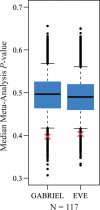The combination of a genome-wide association study of lymphocyte count and analysis of gene expression data reveals novel asthma candidate genes
- PMID: 22286170
- PMCID: PMC3315207
- DOI: 10.1093/hmg/dds021
The combination of a genome-wide association study of lymphocyte count and analysis of gene expression data reveals novel asthma candidate genes
Abstract
Recent genome-wide association studies (GWAS) have identified a number of novel genetic associations with complex human diseases. In spite of these successes, results from GWAS generally explain only a small proportion of disease heritability, an observation termed the 'missing heritability problem'. Several sources for the missing heritability have been proposed, including the contribution of many common variants with small individual effect sizes, which cannot be reliably found using the standard GWAS approach. The goal of our study was to explore a complimentary approach, which combines GWAS results with functional data in order to identify novel genetic associations with small effect sizes. To do so, we conducted a GWAS for lymphocyte count, a physiologic quantitative trait associated with asthma, in 462 Hutterites. In parallel, we performed a genome-wide gene expression study in lymphoblastoid cell lines from 96 Hutterites. We found significant support for genetic associations using the GWAS data when we considered variants near the 193 genes whose expression levels across individuals were most correlated with lymphocyte counts. Interestingly, these variants are also enriched with signatures of an association with asthma susceptibility, an observation we were able to replicate. The associated loci include genes previously implicated in asthma susceptibility as well as novel candidate genes enriched for functions related to T cell receptor signaling and adenosine triphosphate synthesis. Our results, therefore, establish a new set of asthma susceptibility candidate genes. More generally, our observations support the notion that many loci of small effects influence variation in lymphocyte count and asthma susceptibility.
Figures





Similar articles
-
Gene-based analysis of regulatory variants identifies 4 putative novel asthma risk genes related to nucleotide synthesis and signaling.J Allergy Clin Immunol. 2017 Apr;139(4):1148-1157. doi: 10.1016/j.jaci.2016.07.017. Epub 2016 Aug 20. J Allergy Clin Immunol. 2017. PMID: 27554816 Free PMC article.
-
Integrated genomics analysis highlights important SNPs and genes implicated in moderate-to-severe asthma based on GWAS and eQTL datasets.BMC Pulm Med. 2020 Oct 16;20(1):270. doi: 10.1186/s12890-020-01303-7. BMC Pulm Med. 2020. PMID: 33066754 Free PMC article.
-
How powerful are summary-based methods for identifying expression-trait associations under different genetic architectures?Pac Symp Biocomput. 2018;23:228-239. Pac Symp Biocomput. 2018. PMID: 29218884 Free PMC article.
-
Genome-wide association studies for discovery of genes involved in asthma.Respirology. 2011 Apr;16(3):396-406. doi: 10.1111/j.1440-1843.2011.01939.x. Respirology. 2011. PMID: 21276132 Review.
-
Genome-wide expression quantitative trait loci analysis in asthma.Curr Opin Allergy Clin Immunol. 2013 Oct;13(5):487-94. doi: 10.1097/ACI.0b013e328364e951. Curr Opin Allergy Clin Immunol. 2013. PMID: 23945176 Review.
Cited by
-
iGWAS: Integrative Genome-Wide Association Studies of Genetic and Genomic Data for Disease Susceptibility Using Mediation Analysis.Genet Epidemiol. 2015 Jul;39(5):347-56. doi: 10.1002/gepi.21905. Epub 2015 May 22. Genet Epidemiol. 2015. PMID: 25997986 Free PMC article.
-
Using gene expression to improve the power of genome-wide association analysis.Hum Hered. 2014;78(2):94-103. doi: 10.1159/000362837. Epub 2014 Jul 30. Hum Hered. 2014. PMID: 25096029 Free PMC article.
-
Integrative modeling of multi-platform genomic data under the framework of mediation analysis.Stat Med. 2015 Jan 15;34(1):162-78. doi: 10.1002/sim.6326. Epub 2014 Oct 15. Stat Med. 2015. PMID: 25316269 Free PMC article.
-
A meta-analysis of genome-wide association studies of childhood wheezing phenotypes identifies ANXA1 as a susceptibility locus for persistent wheezing.Elife. 2023 May 25;12:e84315. doi: 10.7554/eLife.84315. Elife. 2023. PMID: 37227431 Free PMC article.
-
Integrated analyses of gene expression and genetic association studies in a founder population.Hum Mol Genet. 2016 May 15;25(10):2104-2112. doi: 10.1093/hmg/ddw061. Epub 2016 Feb 29. Hum Mol Genet. 2016. PMID: 26931462 Free PMC article.
References
-
- Manolio T.A., Collins F.S., Cox N.J., Goldstein D.B., Hindorff L.A., Hunter D.J., McCarthy M.I., Ramos E.M., Cardon L.R., Chakravarti A., et al. Finding the missing heritability of complex diseases. Nature. 2009;461:747–753. doi:10.1038/nature08494. - DOI - PMC - PubMed
-
- So H., Gui A.H.S., Cherny S.S., Sham P.C. Evaluating the heritability explained by known susceptibility variants: a survey of ten complex diseases. Genet. Epidemiol. 2011;35:310–317. doi:10.1002/gepi.20579. - DOI - PubMed
-
- Clarke A.J., Cooper D.N. GWAS: heritability missing in action? Eur. J. Hum. Genet. 2010;18:859–861. doi:10.1038/ejhg.2010.35. - DOI - PMC - PubMed
-
- Eichler E.E., Flint J., Gibson G., Kong A., Leal S.M., Moore J.H., Nadeau J.H. Missing heritability and strategies for finding the underlying causes of complex disease. Nat. Rev. Genet. 2010;11:446–450. doi:10.1038/nrg2809. - DOI - PMC - PubMed
-
- Gibson G. Hints of hidden heritability in GWAS. Nat. Genet. 2010;42:558–560. doi:10.1038/ng0710-558. - DOI - PubMed
Publication types
MeSH terms
Grants and funding
LinkOut - more resources
Full Text Sources
Medical
Molecular Biology Databases

